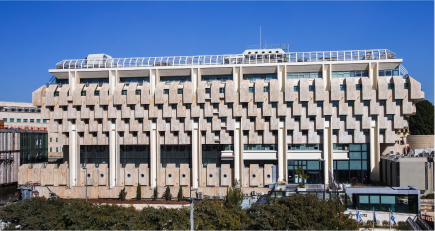
Israeli Banks Win Permission to Pay 50% of Profits as Dividends, Shares Jump 4.7% on Sunday Trading
When Wartime Prudence Meets Capital Markets: Israeli Banks' Dividend Renaissance
TEL AVIV — On Rothschild Boulevard, where the gleaming towers of Israel's financial establishment pierce the Mediterranean sky, Sunday's trading session revealed something profound about the psychology of capital markets during extraordinary times.

Bank Hapoalim shares surged 288 points to 6,457 ILA—a commanding 4.67% advance that marked the institution's strongest single-day performance since early spring. Across the banking sector, the TA Bank 5 Index climbed 4.29%, as investors absorbed news that would have seemed routine in peacetime but carries extraordinary weight amid ongoing regional tensions.
The catalyst: Israeli banks have received authorization to distribute 50% of their profits through the second quarter of 2025 as dividends, representing a pivotal shift from the approximately 40% ceiling that has governed the sector since the outbreak of hostilities. Yet this numerical adjustment masks a deeper transformation—one that illuminates how financial institutions navigate the treacherous waters between wartime caution and shareholder expectations.
The Architecture of Financial Confidence
In the marble-clad boardrooms where these decisions crystallize, the calculus extends far beyond simple arithmetic. The Bank of Israel's accompanying statement carried the weight of institutional philosophy: Israeli banks have "built up excess capital buffers to cover a wide range of risks," while emphasizing that distribution decisions "should take into account the risk environment in which they operate."
Bank capital buffers are mandatory reserves of high-quality capital, such as Tier 1 equity, that banks must hold in addition to minimum requirements. These reserves act as a crucial cushion to absorb unexpected losses during economic downturns, thereby ensuring the bank's solvency and promoting overall financial stability.
This carefully orchestrated language reflects a regulatory establishment attempting to project strength while maintaining prudential vigilance—a balancing act that has defined Israeli financial policy since October 7th reshaped the nation's strategic landscape.

The market's response suggests investors had been anticipating precisely such validation. Within hours of the announcement, trading volumes surged as institutional portfolios recalibrated their exposure to what had become one of the Tel Aviv Stock Exchange's most closely watched sectors.
"The psychological impact of moving from 40% to 50% payout ratios transcends the mechanical mathematics," observed a senior portfolio manager at one of Israel's largest pension funds, speaking anonymously due to firm policy. "Markets are pricing institutional confidence as much as shareholder returns."
Capital Fortress Architecture
The authorization reflects months of behind-the-scenes dialogue between banking executives and supervisory authorities—conversations that reveal the complex calculus of financial resilience during periods of existential uncertainty. Israeli banks have spent the past year constructing what regulators repeatedly characterize as "excess capital and liquidity" reserves, positioning themselves substantially above minimum requirements.
These enhanced buffers were engineered to withstand scenarios ranging from direct conflict escalation to cascading economic disruptions affecting credit quality across critical sectors including construction, small-to-medium enterprises, and consumer lending. The regulatory comfort with higher distributions signals confidence in these defensive preparations.
Bank Leumi, which reported robust 2024 net profits of 9.8 billion shekels, exemplifies this capital fortification strategy. The institution's Common Equity Tier 1 ratio hovers near 12%—well above both regulatory minimums and international peer averages—creating substantial cushion for economic volatility.
Common Equity Tier 1 (CET1) Ratios for major Israeli banks, comparing them to regulatory minimums.
| Bank Name | CET1 Ratio (%) | Regulatory Minimum (%) | As of |
|---|---|---|---|
| Bank Leumi | 12.17 | Not specified in the latest report, 10.2 in June 2023 | Dec 31, 2024 |
| Bank Hapoalim | 11.90 | 10.23 | Sep 30, 2024 |
| Israel Discount Bank | 10.57 | 9.19 | Q3 2024 |
| Mizrahi Tefahot Bank | 10.37 | Not specified in the latest report, 8.7 in 2020 | Q1 2025 |
Yet some market participants express concern about the procyclical implications of this timing. A risk management specialist at a major Israeli institutional investor, requesting anonymity, noted the inherent tension: "Easing capital constraints before achieving complete clarity on macro trajectories—particularly regarding conflict duration and credit quality evolution—introduces tail risks that could prove problematic if conditions deteriorate."
The Political Economy of Bank Profits
The dividend authorization unfolds against a backdrop of heightened political sensitivity around banking sector profitability. A temporary 6% profit surtax, implemented alongside public frustration over mortgage rate increases, creates an environment where visible dividend celebrations could attract unwanted scrutiny or policy reversals.
This political dimension adds complexity to what might otherwise represent straightforward capital allocation optimization. Banking executives must navigate not only regulatory requirements and shareholder expectations, but also public perception in a society bearing the cumulative stress of prolonged uncertainty.
The delicate messaging around the authorization reflects this awareness. Rather than celebrating regulatory accommodation, institutional communications have emphasized continued prudence and risk management—language designed to preempt political backlash while satisfying investor demands for capital efficiency.
Market Mechanics and Momentum Dynamics
Sunday's price action revealed sophisticated positioning dynamics that extend beyond fundamental analysis. Israeli banks had outperformed the broader market substantially year-to-date, creating concentrated institutional ownership that proved highly sensitive to policy relief headlines.
The surge characteristics—rapid momentum accompanied by elevated volume—suggest the move attracted both fundamental investors and technical traders capitalizing on headline-driven volatility. This dual demand profile typically indicates moves capable of either sustaining on confirmation or reversing sharply on disappointment.
The concentration of Israeli bank ownership among pension funds and exchange-traded funds creates additional technical considerations. These institutional structures naturally favor cash-returning strategies, potentially amplifying positive feedback loops when distribution policies become more generous.
Trading specialists noted the dispersion potential among individual institutions. Bank Hapoalim's 4.67% advance outpaced sector averages, reflecting institution-specific factors including balance sheet positioning and previous dividend communication. The bank's substantial retail deposit base and diversified revenue streams position it favorably for sustained higher distributions.
Bank Hapoalim (POLI) stock performance on the Tel Aviv Stock Exchange in 2025.
| Date | Price (ILA) | Event/Note |
|---|---|---|
| 2025-08-06 | 6,163.00 | Price moved over -1.01%. |
| 2025-07-10 | 6,546.00 | 52-week high. |
| 2025-07-10 | 25.21 | Highest end of day price. |
| 2025-06-03 | N/A | Dividend pay-date. |
| 2025-05-27 | N/A | Ex-dividend date. |
| 2025-08-13 | N/A | Publication date of Q2 2025 report. |
Investment Architecture for Professional Positioning
For sophisticated market participants, the current environment presents nuanced opportunities requiring calibrated risk management. The headline-driven rally creates immediate positioning questions, while longer-term implications depend heavily on policy confirmation and economic evolution.
Several monitoring priorities emerge from this development. The authenticity of reported policy shifts awaits formal confirmation through Bank of Israel circulars or official issuer filings. Until such documentation materializes, market participants should consider the possibility that current reports reflect bank-specific approvals rather than system-wide policy transformation.
From a credit markets perspective, immediate spread implications appear minimal given existing capital strength. However, future macro shocks—particularly in construction sector credit quality—could experience amplification through thinner cushions relative to current levels.
A credit spread is the difference in yield between a corporate bond and a risk-free government bond of the same maturity, representing the extra compensation an investor receives for taking on higher default risk. These spreads widen when investors perceive increased economic risk, as they demand a greater return to compensate for the added uncertainty.
The dispersion potential among institutions merits tactical consideration. Bank Leumi has explicitly telegraphed intentions to return "at least 50%" of profits over the 2025-2026 period, positioning the institution for disproportionate benefit from regulatory accommodation. Competitors including Israel Discount Bank would likely pursue matching policies to maintain competitive positioning.
Scenario Architecture and Probability Weighting
Professional traders should consider multiple probability-weighted outcomes when positioning around this development. The base case scenario envisions continued adherence to approximately 40% blended returns through at least third-quarter earnings, with select institutions receiving case-by-case approvals for higher distributions contingent on sustained stability.
An upside scenario involves formal clearance for multiple banks to target 50% distributions during fourth-quarter earnings season, contingent on macro stability and adequate funding of mandated relief programs. Such developments could drive additional index appreciation as buyback mathematics improve sustainability metrics.
Conversely, downside risks include potential regulatory re-tightening should credit or geopolitical conditions deteriorate. The supervisor's historical emphasis on maintaining adequate cushions suggests policy reversibility remains an active consideration, particularly given ongoing uncertainty around conflict duration and economic impact trajectories.
The timeline for clarification appears concentrated around upcoming earnings disclosures. Bank Leumi's August 13 results presentation will likely provide crucial guidance regarding actual implementation versus theoretical authorization.
The Broader Financial Ecosystem
This episode illuminates fundamental questions about financial system resilience and capital allocation during periods of heightened uncertainty. Israeli banks' ability to maintain robust operations while simultaneously returning enhanced capital to shareholders demonstrates institutional strength, but also highlights ongoing tension between prudential regulation and market expectations.
The success of this policy adjustment will ultimately depend on factors extending far beyond dividend mathematics. Regional stability evolution, credit quality trajectories, and the broader path of Israel's economic adaptation to prolonged uncertainty will determine whether current optimism proves prescient or premature.

For institutional investors, Sunday's market action suggests appetite for rewarding regulatory confidence, even amid ongoing challenges. Whether this confidence translates to sustained outperformance will depend on execution quality, formal policy confirmation, and the complex interplay of factors continuing to shape Israel's financial architecture during these extraordinary circumstances.
The dividend authorization represents more than policy adjustment—it embodies institutional belief in the durability of Israel's financial infrastructure during one of its most challenging periods. That belief, expressed through market prices and regulatory confidence, will face its ultimate test in the months ahead.
Investment considerations discussed in this analysis are for informational purposes only and should not be construed as personalized financial advice. Past performance does not guarantee future results. Readers should consult qualified financial advisors before making investment decisions.